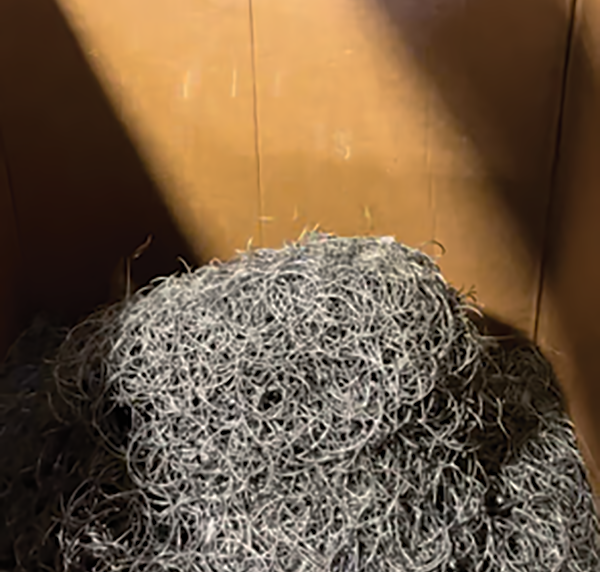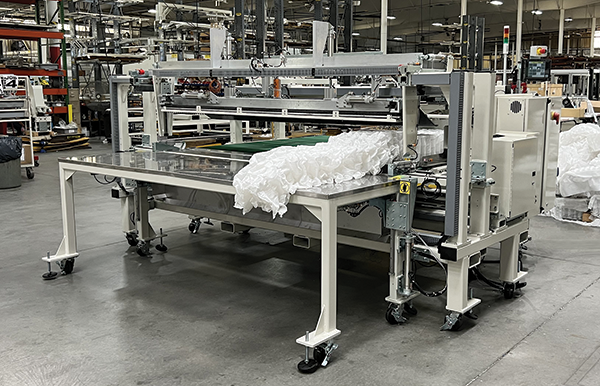Eric Buck jokes that he lost a lot of hair, gained several pounds and aged 15 years trying to develop an automated system to dismantle pocketed coil units at the end of a mattress’ useful life.
It took 39 months, but he and his partners did it, creating what they now call the Bedder Shredder.
Buck is not the only one to take on the challenge of trying to efficiently automate the process of separating steel coils from the fabric (typically polypropylene) that encases them.


The Mattress Recycling Council invests $1 million a year to improve the recyclability of mattresses. In 2019, it awarded a contract to Knoble Design, a custom engineering company in Soldiers Grove, Wisconsin, which had conceived a process that would quickly and affordably separate the coils and the fabric. In 2021, Lawrenceville, Georgia-based Atlanta Attachment Co. purchased the Knoble Design prototype and all related intellectual property to scale the system for widespread use, says Doug Guffey, chair of the Mattress Recycling Council board and vice president of sales for Hickory Springs Manufacturing’s bedding division.
Conversations with Buck and Guffey, as well as recycler Mike Gurnee and Texas Pocket Springs’ owner and CEO Martin Wolfson, illuminate important recent advancements in automated recycling and continuing efforts to improve the process.
A recycling revolution
When Mike Gurnee, CEO of Xtraction Inc. in Fresno, California, and Tough Stuff Recycling in Fitchburg, Massachusetts, got involved in mattress recycling in 2019, most of the dismantling work was being done by hand — and most pocketed spring units in California ended up in landfills because that wasn’t a cost-effective way to disassemble them.

Atlanta Attachment Co. has developed the 1314R pocketed spring recycling system, after buying a prototype and related intellectual property developed by Knoble Design LLC. A research grant from the Mattress Recycling Council helped fund Knoble Design’s work on the initial concept. It’s an example of industry collaboration to advance sustainability.
“But I knew from the beginning that there had to be some automation and so we went back to the drawing board, went to a couple vendors we knew, and we did some engineering and designed a system to take a lot of the labor requirements out of it,” he says.
Now, by incorporating a mix of shredding and separation machinery, Xtraction can cleanly separate the steel and fabric, with less labor. “Let me be very honest,” he says. “The type of equipment we utilize is very expensive. If I only did mattresses for Rhode Island, let’s say, I would not be putting in a system like I have. It just wouldn’t be feasible. … So, volume is the key to a system like this.” But Gurnee’s Xtraction facility has that volume: It now takes in pocketed spring units from other
recyclers in California, doing the dismantling they don’t have the equipment or staff to handle.
Gurnee recently installed “version 2.0” of the dismantling system at his Tough Stuff Recycling facility in Massachusetts. It’s also a high-volume recycler, taking in mattresses from Massachusetts, Rhode Island and occasionally New Hampshire and Vermont.
“We’ve figured it out”
Buck first learned of the challenges of recycling pocketed spring units more than a decade ago when his company began processing a variety of waste types — including damaged or otherwise unusable pocketed coil units — for a major bedding industry supplier. Although Buck would later learn the value of nonwoven polypropylene fabric, at the time he was eager to take the units because steel was profitable, and he had several buyers.
But it didn’t take long for his sources to start refusing the unprocessed spring units because they were ruining their shredding machines by wearing down blades and getting tangled around their augers, causing lengthy breakdowns.
“At that point, we thought, ‘Are we going to have to do this ourselves?” Buck recalls. With the help of partners Craig Conrad and Nick Ruehlman, Buck began to design an automated system that would separate the fabric and steel, without damaging the recycling machinery, while achieving a 100% recycling rate.
During development, Buck estimates, his team went through as many as 40 blade sets. Through trial and error, they were able to create what is now known as the Bedder Shredder.
The now-patented Bedder Shredder has been in use for several years and, Buck says, it has proven to be “the most cost-effective solution for both post-industrial and post-consumer pocketed spring units.” To market the machine more broadly, Buck and his partners formed a new company, Pocket Coil Recycling, which showcased the system at the ISPA Sustainability Conference last fall.
The Bedder Shredder is available in three configurations and, depending on the setup, can be run by one or two operators. Buck says the line is “extremely low maintenance.”
“We haven’t had any breakdowns in over five years and haven’t had to replace any parts other than the blades,” he says. And those blades now have a long life: The team had to replace the first set of blades on its prototype after processing 30,000 pounds of material. “We just surpassed 2 million pounds on our last blade set,” Buck says.
Once the pocketed spring unit runs through the Bedder Shredder, both commodities “are presented in an extremely desirable condition,” Buck says, so much so that he will purchase the materials back to use in his own material configurations.
“I want everyone to know that there isn’t a problem recycling pocketed spring units anymore,” Buck says. “We have transformed what was once deemed a definite waste stream into a revenue stream. We’ve figured it out.”
A circular solution
In its efforts to improve the recyclability of pocketed spring units, Alvarado, Texas-based Texas Pocket Springs has created glueless assembly systems and a line of glueless QuadCoil spring units.
But like some other industry players who are taking their sustainability efforts in new and more expansive directions, Texas Pocket Springs is branching out to develop a recycling machine of its own. Martin Wolfson, owner and CEO of the company, says the machine, still in the design and prototype stage, will efficiently remove the coil unit from the pockets and chop the steel into pieces. The remaining spun-bond polypropylene fabric can then be shredded and reused as a nonwoven in spring units.
The company is planning two versions of the machine: one for use by landfills that could disassemble a coil unit in a minute and a smaller version that could be used by mattress manufacturers who wish to take back mattresses and reuse or sell the shredded steel and polypropylene, Wolfson says. The goal is for that smaller unit to dismantle a unit in two to three minutes.
Wolfson intends to install a version of the machine in his own plant. “We want to be totally cradle to cradle,” he says. “It’s a very, very far out goal, but I believe that can be achieved. We have the know-how.”
“Moving light-years ahead”
Although they are on the supplier side of the business, Guffey and recently retired Atlanta Attachment President Hank Little had seen that there was a growing need for an efficient, cost-effective way to disassemble pocketed coils, thanks to their long involvement in the bedding industry, MRC and the International Sleep Products Association.
When Guffey and Little learned of the small-scale prototype machine Jesse Knoble of Knoble Design had created with the help of the MRC grant, they wanted to know more.
“We met with Jesse up in Wisconsin, went to the shop and had long conversations,” Guffey recalls. “We thought that what he had developed was a really good start, and we thought that Atlanta Attachment would have the best opportunity to get it out into the marketplace.”
The machine works by putting a bit of tension on the pocketed spring unit, cutting the bottom of the fabric encasement and using a “finger system” to grab the coils and pull the unit out of the fabric, Guffey explains.
“At the end,” he says, “you’ve got clean products: You’ve got your metal coils and then you’ve got your polypropylene that’s really easy to bale.”
Atlanta Attachment showed the machine, now called the 1314R, at ISPA EXPO in March 2022 and continues to refine it but has already had strong customer interest from around the globe. The 1314R can be run by a single operator and is designed to dismantle a pocketed spring unit in three to four minutes.
Mattress recyclers, especially small to medium-size operations, are target customers, as are producers of spring units, mattress manufacturers and waste management operators, Guffey says.
“We sold our first unit at ISPA EXPO and have had a lot of interest since Interzum Cologne (in May 2023),” he says. “It’s exciting. … (Pocketed spring dismantling) has been a problem for a long time, and we’ve seen a lot of rudimentary methods: You know, a guy with an X-Acto knife cutting pockets and pulling out the springs using a little butane torch to pop the pockets and pull the metal out. You look at something like that and anything is an improvement. Now we’re moving light-years ahead.”





